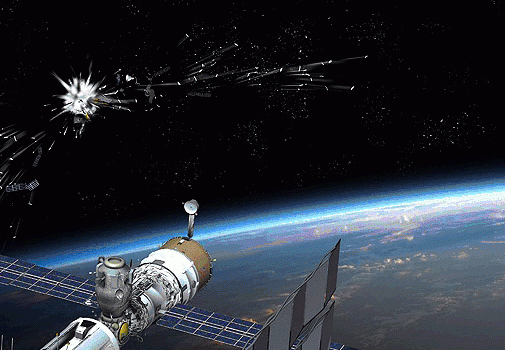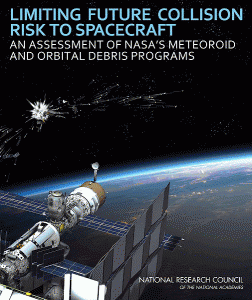
Limiting Future Collision Risk to Spacecraft
An Assessment of NASA’s Meteoroid and Orbital Debris Programs
National Research Council of the National Academies
 Over the past 50 years, various NASA communities have contributed significantly to maturing NASA’s meteoroid and orbital debris (MMOD)1 programs to their current state. As a result of these community efforts, and to NASA’s credit, NASA’s MMOD programs and models are now widely used and respected by the providers and users of both government and commercial satellites, nationally as well as internationally. Satellites have been redesigned to protect critical components from MMOD damage by moving critical components from exterior surfaces to deep inside a satellite’s structure. Orbits are monitored and altered to minimize the risk of collision with tracked orbital debris. MMOD shielding added to the International Space Station (ISS) protects critical components and astronauts from potentially catastrophic damage that might result from smaller, untracked debris and meteoroid impacts.
Over the past 50 years, various NASA communities have contributed significantly to maturing NASA’s meteoroid and orbital debris (MMOD)1 programs to their current state. As a result of these community efforts, and to NASA’s credit, NASA’s MMOD programs and models are now widely used and respected by the providers and users of both government and commercial satellites, nationally as well as internationally. Satellites have been redesigned to protect critical components from MMOD damage by moving critical components from exterior surfaces to deep inside a satellite’s structure. Orbits are monitored and altered to minimize the risk of collision with tracked orbital debris. MMOD shielding added to the International Space Station (ISS) protects critical components and astronauts from potentially catastrophic damage that might result from smaller, untracked debris and meteoroid impacts.
The space shuttle, as it orbited Earth, and whether docked to the ISS or not, was optimally oriented to protect its fragile thermal protection and thermal radiation systems from MMOD damage. In addition, astronauts inspected its thermal protection system for MMOD damage before the shuttle reentered Earth’s atmosphere; Orion, NASA’s capsule to carry astronauts to low Earth orbit, includes designs to mitigate the threat of MMOD damage and provide increased safety to the crew.
When a handful of reasonable assumptions are used in NASA’s MMOD models, scenarios are uncovered that conclude that the current orbital debris environment has already reached a “tipping point.” That is, the amount of debris—in terms of the population of large debris objects, as well as overall mass of debris in orbit—currently in orbit has reached a threshold where it will continually collide with itself, further increasing the population of orbital debris. This increase will lead to corresponding increases in spacecraft failures, which will only create more feedback into the system, increasing the debris population growth rate. The increase thus far has been most rapid in low Earth orbit (LEO), with geosynchronous Earth orbits (GEOs) potentially suffering the same fate, but over a much longer time period. The exact timing and pace of this exponential growth are uncertain, but the serious implications of such a scenario require careful attention because of the strategic importance of U.S. space operations.
The Office of Science and Technology Policy and the Office of Management and Budget, contracted with the National Research Council for a study to perform three tasks: review NASA’s MMOD programs and efforts, recommend in which of those NASA should increase or decrease its effort or change focus, and determine whether NASA should pursue work in any new MMOD areas. The official letter requesting the study and the full statement of task for the Committee for the Assessment of NASA’s Orbital Debris Programs are in Appendixes A and B, respectively.

















































































































![A trajectory analysis that used a computational fluid dynamics approach to determine the likely position and velocity histories of the foam (Credits: NASA Ref [1] p61).](https://www.spacesafetymagazine.com/wp-content/uploads/2014/05/fluid-dynamics-trajectory-analysis-50x50.jpg)



Leave a Reply